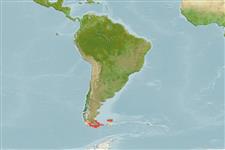Environment: milieu / climate zone / depth range / distribution range
Ecology
Marine; demersal; depth range 40 - 50 m. Temperate; 52°S - 57°S
South Atlantic and South Pacific: Straits of Magellan, south of Chile and Argentina, Patagonian Region and Staten Island. Falkland Islands and subantarctic islands (Ref. 4537).
Size / Weight / Age
Maturity: Lm ? range ? - ? cm
Max length : 9.5 cm SL male/unsexed; (Ref. 117667)
Mainly in shallow, inshore waters, but may be found from 40-50 m. Occurs in tide pools, under rocks and among kelp (Ref. 5191). Feed on small crustaceans and common in littoral of all sub-Antarctic islands (Ref. 42041).
Life cycle and mating behavior
Maturity | Reproduction | Spawning | Eggs | Fecundity | Larvae
Females guard the eggs deposited in a nest they constructed for the four month incubation period (Ref. 89358).
Hureau, J.-C., 1990. Harpagiferidae. p. 357-363. In O. Gon and P.C. Heemstra (eds.) Fishes of the Southern Ocean. J.L.B. Smith Institute of Ichthyology, Grahamstown, South Africa. 462 p. (Ref. 5191)
IUCN Red List Status (Ref. 130435: Version 2024-2)
Threat to humans
Harmless
Human uses
Fisheries: of no interest
Tools
Special reports
Download XML
Internet sources
Estimates based on models
Preferred temperature (Ref.
123201): 6.2 - 8, mean 7.1 °C (based on 8 cells).
Phylogenetic diversity index (Ref.
82804): PD
50 = 0.5010 [Uniqueness, from 0.5 = low to 2.0 = high].
Bayesian length-weight: a=0.00525 (0.00206 - 0.01336), b=3.10 (2.88 - 3.32), in cm total length, based on LWR estimates for this (Sub)family-body shape (Ref.
93245).
Trophic level (Ref.
69278): 3.3 ±0.4 se; based on diet studies.
Resilience (Ref.
120179): Medium, minimum population doubling time 1.4 - 4.4 years (Assuming Fec < 10,000).
Fishing Vulnerability (Ref.
59153): Low to moderate vulnerability (35 of 100).
